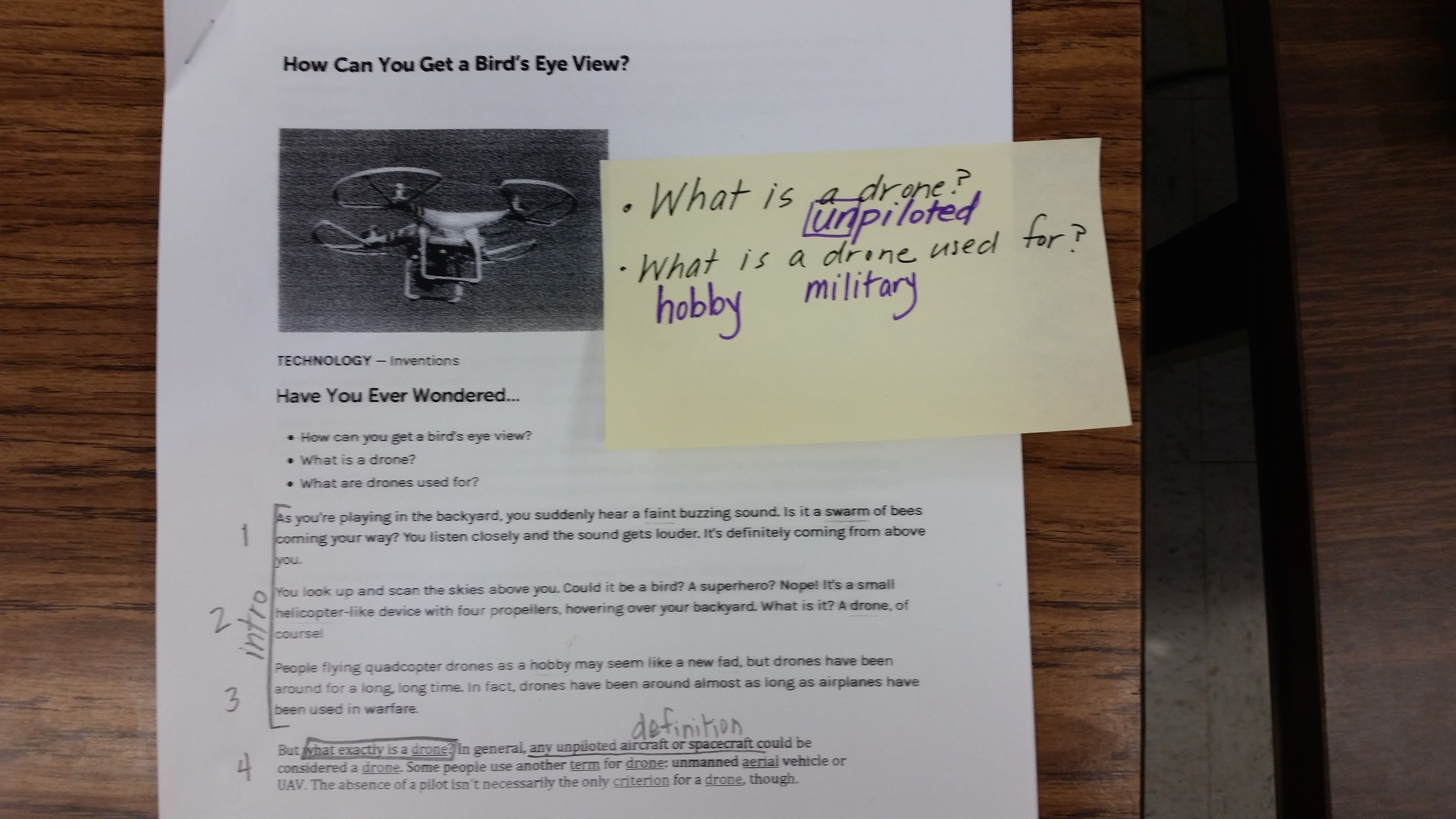Teaching the language of text structures can help students compare and contrast texts more easily.
I gave a lesson to a 5th/6th grade class a few weeks ago with two current event articles on drones. The first article “How can you get a bird’s eye view?” from Wonderopolis is written in an enumerative (or descriptive) text structure. There is the overarching topic of drones and then sub-topics that describe or explain different aspects of drones. The students did an initial read for the purposes of answering the questions, “What is a drone?” and “What are drones used for?” If you skip down to the image after next, you’ll see that I posted the questions for the students to consider during this initial read and then to discuss in pairs. I jotted down a couple of key words before they talked with a partner.
Then I posted the definition of a descriptive text (I thought “enumerative” might be too abstract).

After I posted the definition and explained briefly, we engaged in a 2nd read to identify the different sub-topics – putting a box around a word or phrases in each paragraph that identified the sub-topic. Below is an image of my copy of the article that was projected with the document camera. I modeled thinking aloud about how the first three paragraphs were an introduction and then I read aloud and thought aloud about how the fourth paragraph was focused on defining drones.

I followed by introducing the 2nd article – “Drone Control” from Scholastic News. (This article is no longer available; try NEWSELA “As drone popularity rises, so do concerns.”) I asked the students to read the article and to think about any additional information they were learning that wasn’t in the first article. After they read and discussed this in small groups, I introduced the text structure for this article – problem-solution.

We did a 2nd read to identify details that revealed problems and solutions. Below is my copy of the article that was projected with the doc camera and that I marked on to model identifying problem and solution details before releasing responsibility to partners. Notice that the author doesn’t write a problem and then a solution. Instead there are multiple problems posed and more than one solution – this is a complex text!

By highlighting the differences in structure, it was very easy to talk about the differences in content.
Grrrr… If you remember my last blog entry, I don’t believe that texts always have easily identifiable structures. Most of the time they don’t. (In that blog entry, I describe using a building analogy to help students understand simple and more complex text structures.) If I’d had the opportunity, I would have followed up this lesson with a third article, Scholastic’s “Invasion of the Drones” which I think at first glance has an enumerative structure–it lists several sub-topics related to drones. On a closer look, though, I think it would be helpful if students realized that each of the sub-topics is an EFFECT of drones, a circumstance (etc.) that is CAUSED by drones. So at the micro-structure level (a part of a text within a larger text) there are causal relationship structures.
If students understand and can easily use words like text structure, descriptive, sub-topics, dimensions of a topic, problem-solution, author poses, causal relationships and so forth to describe the texts they are reading, they will more easily be able to compare and contrast content as well as remember that content and perhaps even think critically about it.
In other words, I’m not looking for students to say, “This is a problem-solution text structure.” I want students to be able to say, “When I was reading this, I noticed that the author poses several problems with drones like… and that he also poses solutions to some but not all of these problems like…” OR “When I was reading this, I noticed that the author describes several different dimensions of drones or sub-topics related to drones like…”
I explain text structures further in my book Unpacking the Complexity of Informational Texts, Chapter Four “What do we mean by a text’s structure?” or in Close Reading of Informational Sources, p. 145-149.


Hope this helps.
S
